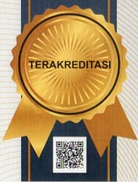Pemanfaatan Data Smartphone Untuk Prediksi Tingkat Risiko Gagal Bayar Debitur
Abstract
The purpose of this study is to demonstrate that smartphone usage data can be used to make predictions and find the best classification method for Credit Scoring even if the sample dataset is small. The study used a classification algorithm to divide customers into paying and arrears customers using mobile data, and then compared the predicted results with the actual results. There are several related works that are publicly accessible where mobile data has been used for Credit Scoring, but all of them use much larger data samples. Small companies cannot use large data sets as used in previous studies. In this paper the author tries to argue that there is data smartphone has good predictive power even though the dataset is small. The author concludes that with a sample data consisting of smartphone data as many as 5,702 debtors can still predict credit risk well. The best classification method using random forest yielded a result of 0.68 AUC equivalent to a ratio of 0.36
Keywords : credit scoring, classification, smartphone dataFull Text:
PDF (Bahasa Indonesia)References
J. Rimmer, "Contemporary changes in credit scoring. Credit Control," Credit Control, vol. 26, no. 4, pp. 56-60, 2005.
C. Wendel and M. Harvey, "Credit scoring: Best practices and approaches," Commercial Lending Review, vol. 18, no. 1, p. 4, 2003.
R. Anderson, The Credit Scoring Toolkit: Theory and Practice for Retail CreditRisk Management and Decision Automation, Oxford University Press, 2007.
M. Banasiak and G. Kiely, "Predictive collection score technology," Business Credit, vol. 102, no. 2, pp. 18-34, 2000.
C. Hodgson, "The world’s 2 billion unbanked, in 6 charts," 2017.
W. Lance, "2011 ends with almost 6 billion mobile phone subscriptions (2012),," 2012.
M. D. Back, J. M. Stopfer, S. Vazire and Gaddis, "Facebook profiles reflect actual personality, not self-idealization," Psychological science, vol. 21, no. 3, pp. 372-374, 2010.
G. Chittaranjan, J. Blom and D. Gatica Perez, "Mining large-scale smartphone datafor personality studies," Personal and Ubiquitous Computing, vol. 17, no. 3, pp. 433-450, 2013.
J. N. Crook, D. B. Edelman and L. C. Thomas, "Recent developments in consumer credit risk assessment. 183(3), 1447– 1465 (2007)," European Journal of Operational Research, vol. 183, no. 3, pp. 1447-1465, 2007.
L. C. Thomas, "A survey of credit and behavioural scoring: forecasting financial riskof lending to consumers. 16(2), 149–172 (2000)," International journal of forecasting, vol. 16, no. 2, pp. 149-172, 2000.
D. Bjrkegren and D. Grissen, The development of credit scoring quality measures forconsumer credit applications. Netmob (2013), Netmob, 2013.
J. S. P. Pedro, D. Proserpio and N. Oliver, "Mobiscore: towards universal credit scoring from mobile phone data," International Conference on User Modeling, Adaptation, and Personalization, pp. 195-207, 2015.
S. Speakman, E. Mibuari, I. Markus and F. Kwizera, Mobile phone-based creditscoring. NetMob Book of Abstracts, NetMob Book of Abstracts, 2017.
T. Harris, "Quantitative credit risk assessment using support vector machines: Broad versus narrow default definitions," Expert Systems with Applications, vol. 40, no. 11, pp. 4404-4413, 2013.
DOI: https://doi.org/10.32487/jst.v9i1.1603
Refbacks
- There are currently no refbacks.
Copyright (c) 2023 JST (Jurnal Sains Terapan)
View My Stats


